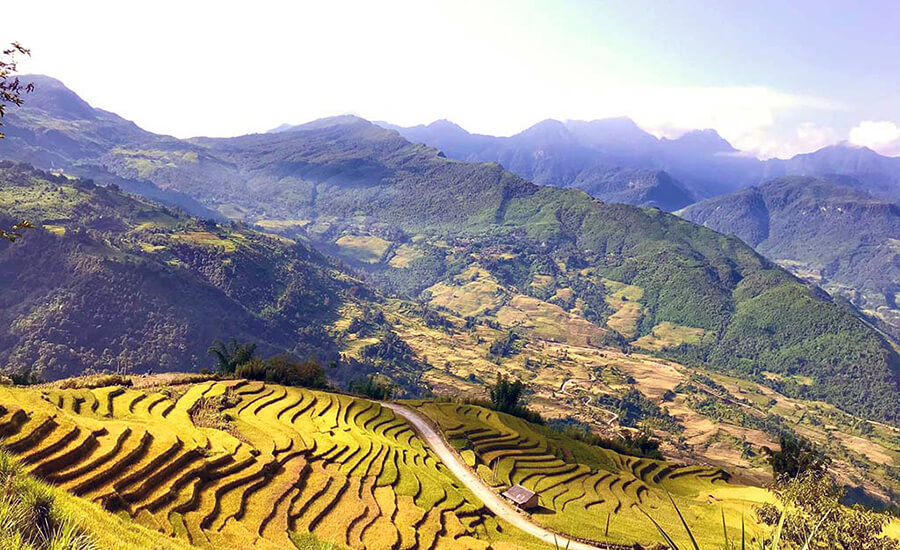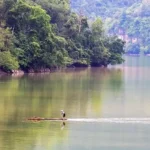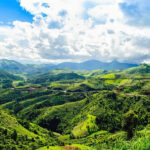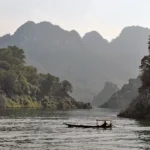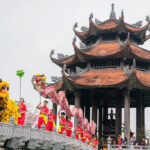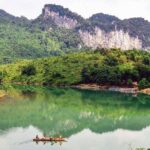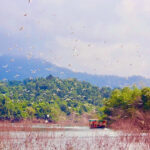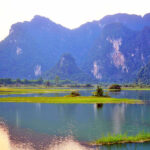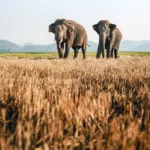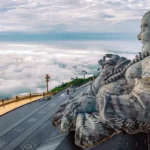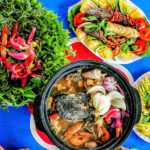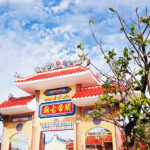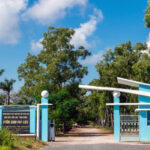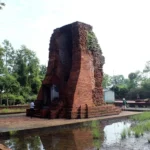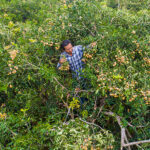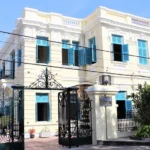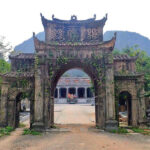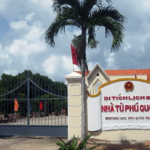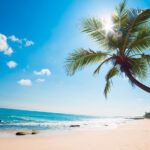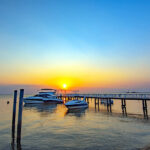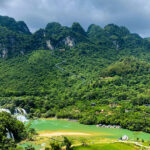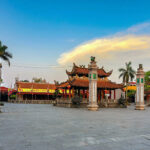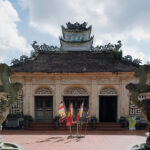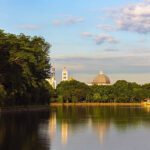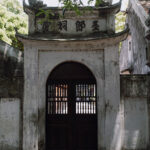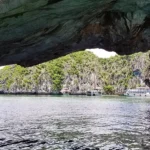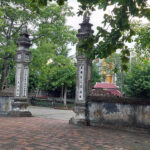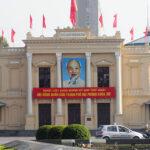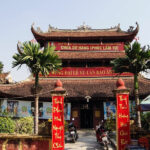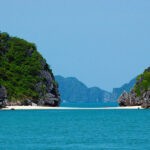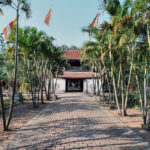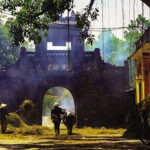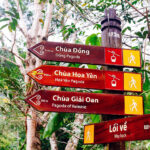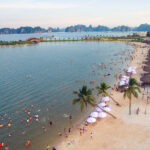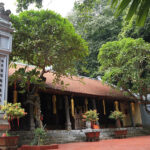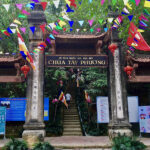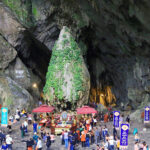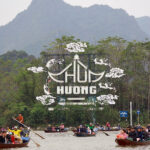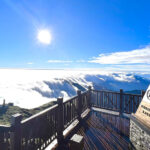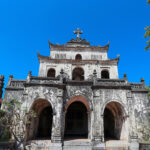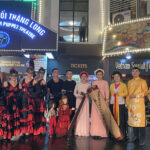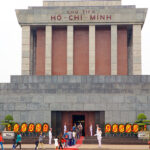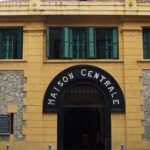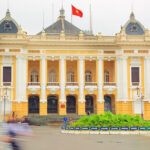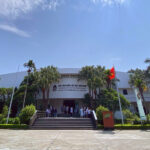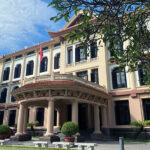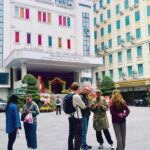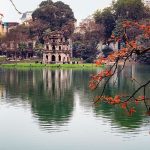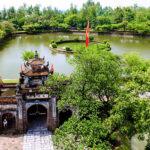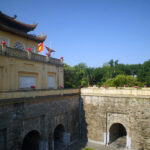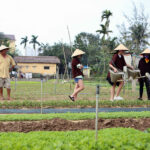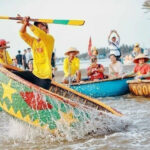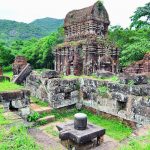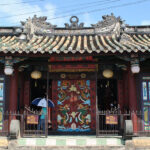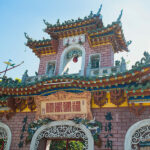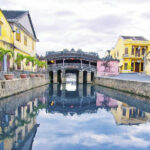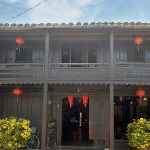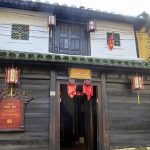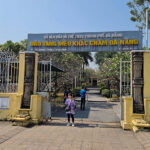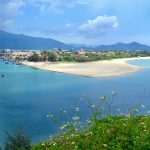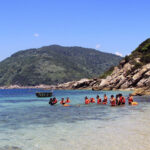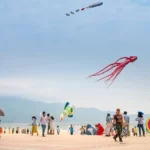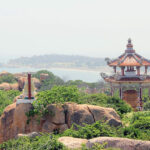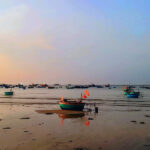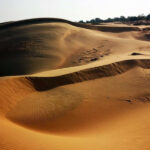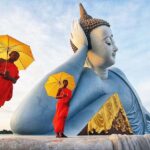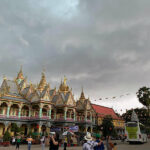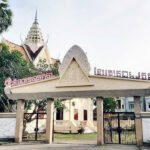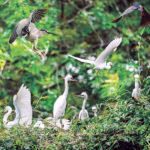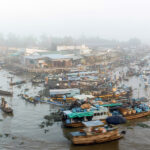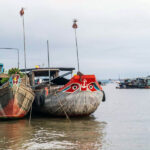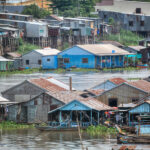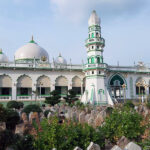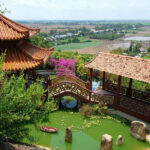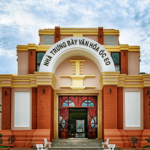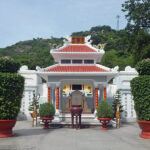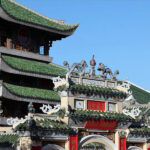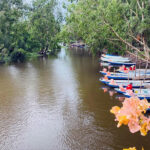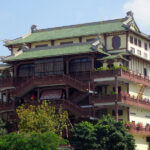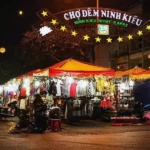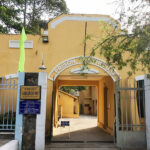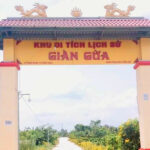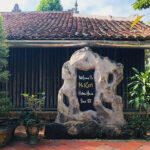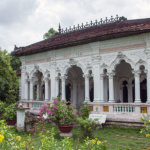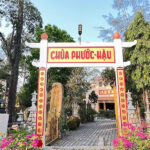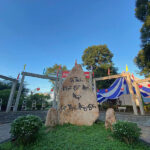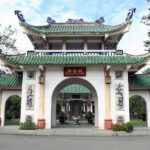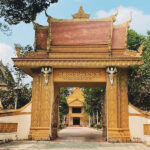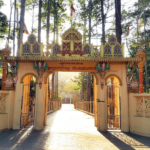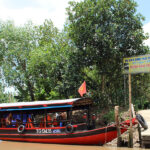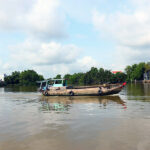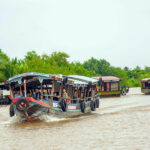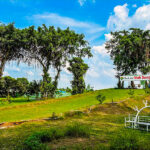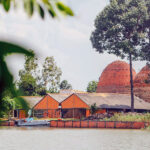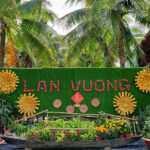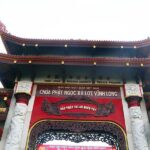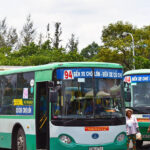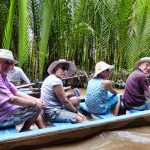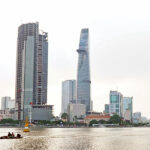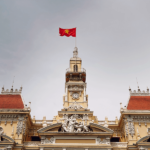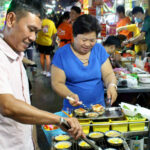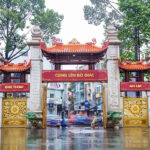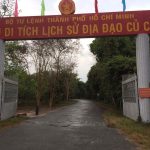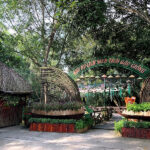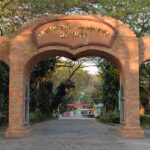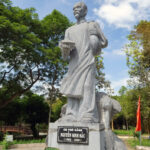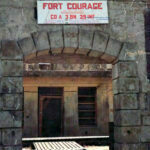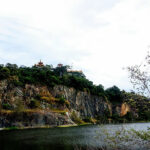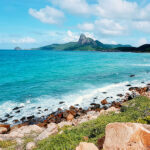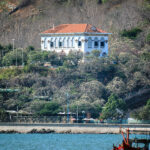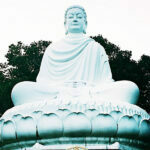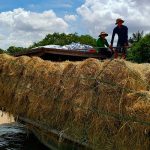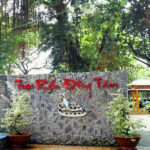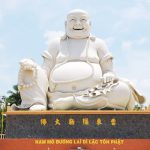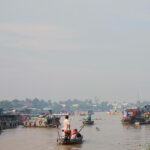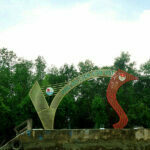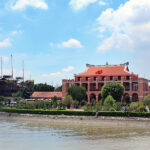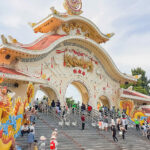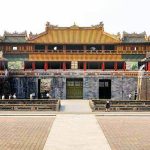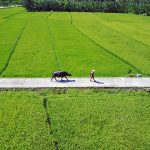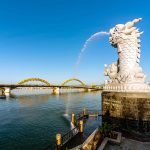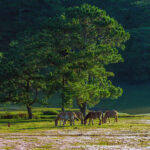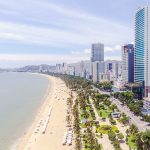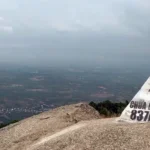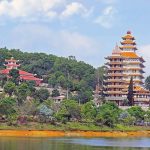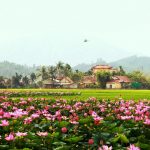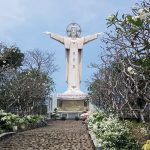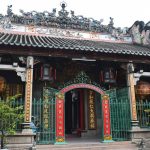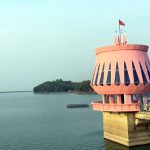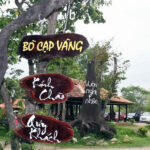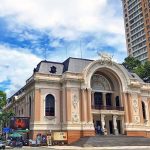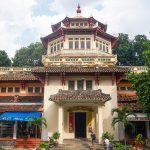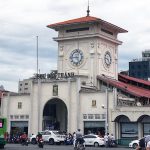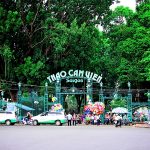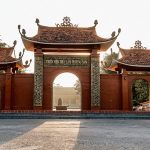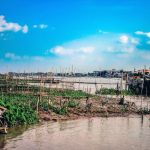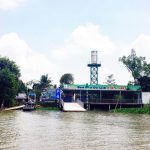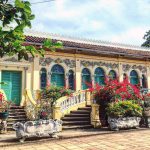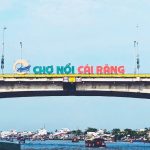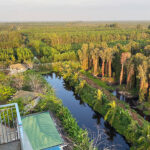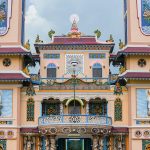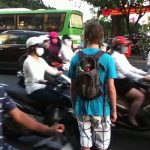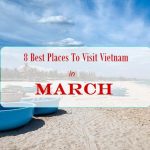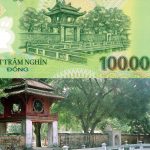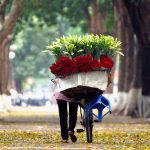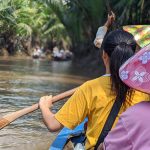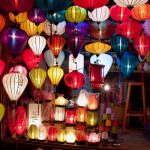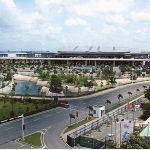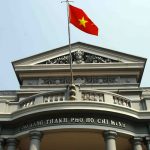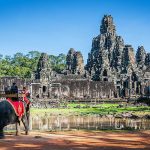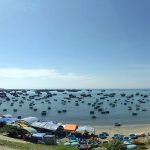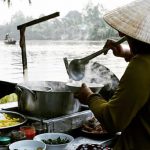Lao Cai has become a leading destination for nature tourism and adventure sports in Vietnam and the region, associated with the traditional cultural identity of ethnic minorities, where visitors will have different and authentic experiences beyond expectations with special emotions on each journey.
Table of Contents
General information about Lao Cai
Lao Cai is a mountainous border province in the Northwest region of Vietnam, sharing a border with Yunnan province, China. Lao Cai has an important position in the Northwest region, is the gateway connecting Vietnam with the region and the world, and is also a bustling economic, cultural, tourism and trade center.
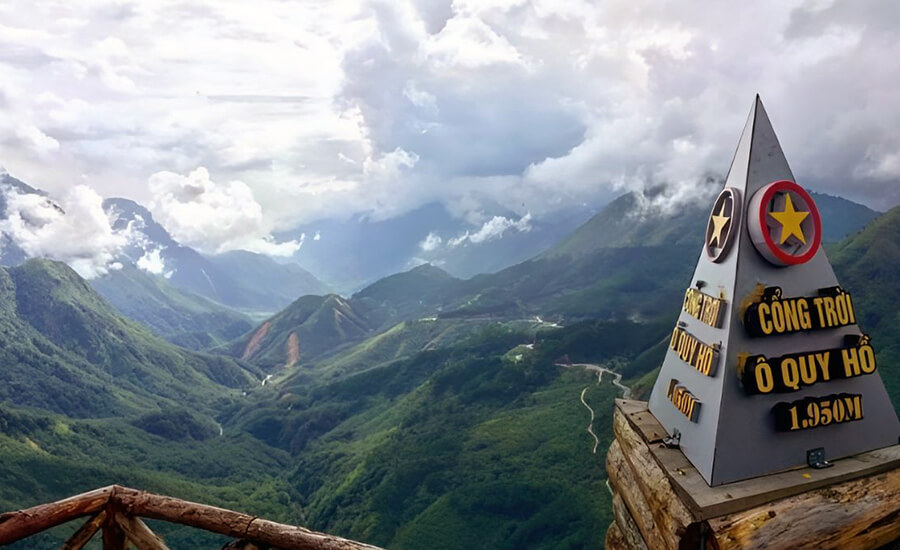
O Quy Ho peak, in Lao Cai
After merging with Yen Bai, Lao Cai province has an area in total of 13.256,92 km². The administrative center of the province is Yen Bai ward, about 155 km from the center of Hanoi. This is a multi-ethnic province, rich in cultural identity with an extremely rich, diverse and unique cultural treasure.
What’s the best time to visit Lao Cai?
The diverse terrain creates different climate zones in Lao Cai province. Especially in the high mountains such as Sa Pa, Si Ma Cai, Bat Xat, Bac Ha, the weather is cool in the summer and cold in the winter. The average annual temperature in the highlands is from 15ºC – 20ºC (in Sa Pa alone, it is from 14ºC – 16ºC). The average annual temperature in the lowlands is from 23ºC – 29ºC. The climatic conditions make Lao Cai an ideal resort destination, especially for domestic tourists.

View of golden terraced fields in Mu Cang Chai, Lao Cai.
Lao Cai is most beautiful in autumn (September – November) and spring (March – May), when nature and weather are at the ideal time for tourism. Autumn brings a scene of golden terraced fields, clear blue sky and cool air, very suitable for sightseeing and taking photos.
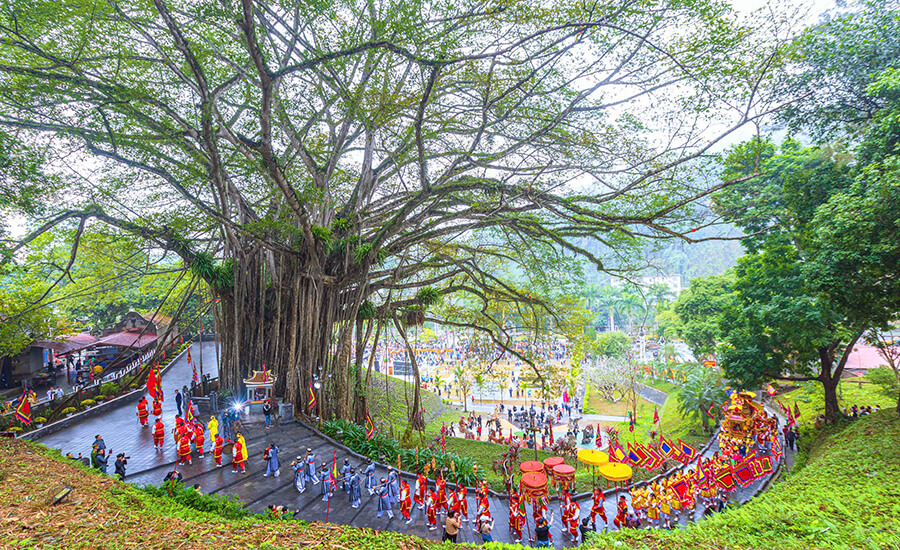
Meanwhile, spring is brilliant with peach and plum blossoms blooming all over the mountains and forests, combined with many unique traditional festivals, creating a harmonious cultural and natural experience. If you want to fully explore the beauty of Lao Cai, these are the two times you should go the most in the year.
How to get there?
Lao Cai is about 155km from the center of Hanoi and is very easy to travel by many means. If you depart from Ho Chi Minh City, you first need to fly to Hanoi, then you can choose different means of transport to Lao Cai:
– Tourist bus or limousine: is the most popular and convenient choice, with reference fares from 220,000 – 550,000 VND depending on the type. The car will travel along the Noi Bai – Lao Cai highway (CT05), with a time of only about 4-5 hours.
– Train: is a suitable choice if you want to experience the night journey. The SP1 (21:35) and SP3 (22:00) depart from Hanoi station and arrive at Lao Cai station the next morning after about 8 hours. Ticket prices range from 600,000 – 1,200,000 VND depending on the compartment. After arriving at Lao Cai station, you can continue to Sa Pa center by bus or taxi, the price is about 55,000 VND/trip, the distance is less than 2km around the Stone Church area.
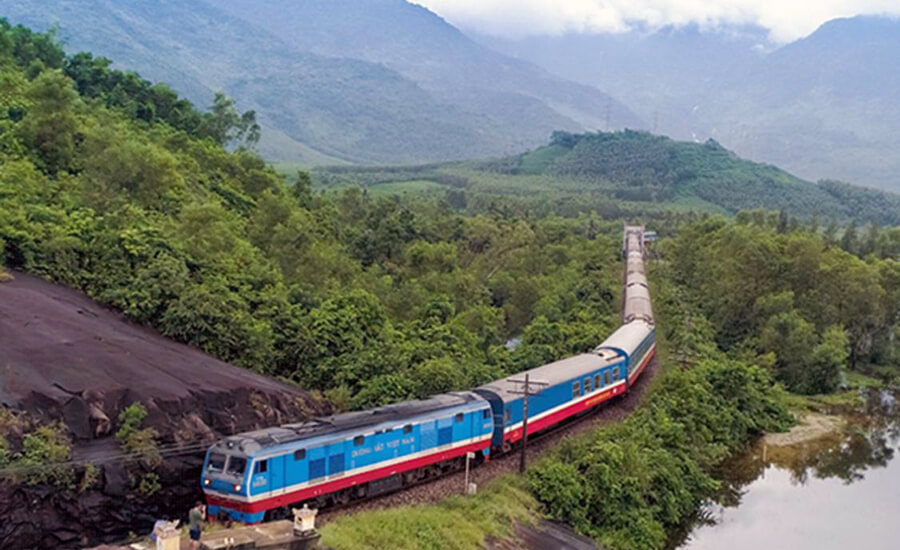
In addition, private car from Hanoi to Sapa or motorbikes are also options for those who want to explore and take the initiative in their schedule. However, you need to have experience driving on mountain passes, ensuring safety because the terrain has many slopes and curves.
Accomodations in Lao Cai
Lao Cai has a variety of accommodation options to suit all needs and budgets, from luxury hotels, homestays to budget motels. In Lao Cai center, you can choose 2-4 star hotels near the center or train station for convenient travel such as Aristo International Hotel, Sapaly Lao Cai Hotel.

a view from a homestay in Lao Cai (source: booking).
In Sa Pa area, you will have more options such as luxury resorts, mountain view hotels, private villas or cozy homestays in the middle of the village. Some hotels that are loved by tourists in Sa Pa include Sapa Horizon Hotel, BB Hotel Sapa, Hotel de la Coupole – MGallery, or homestays such as Phơri’s House, Eco Palms House. Popular accommodation areas are around Sa Pa Stone Church, Fansipan Street, Muong Hoa, Cau May… because they are close to check-in points and have beautiful scenery.
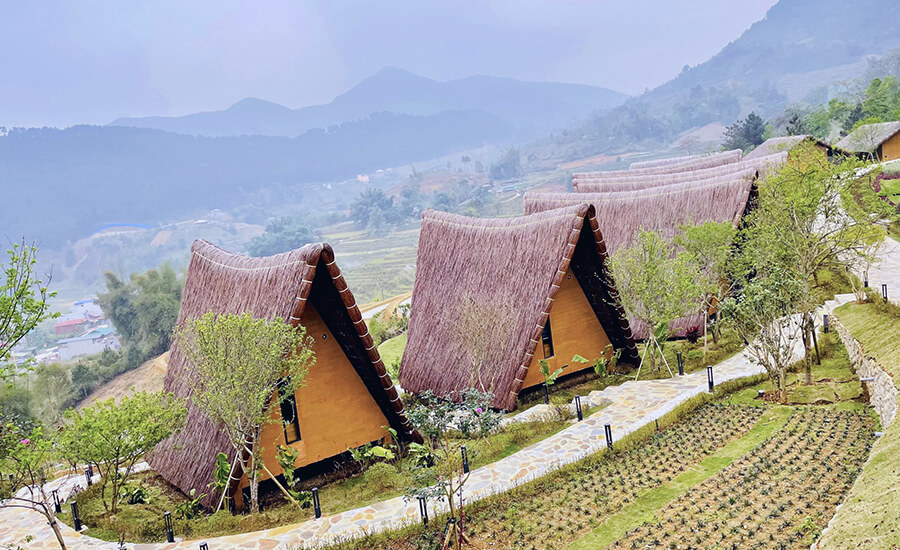
Le Champ resort in Tu Le.
In the Mu Cang Chai area, hotels here are also mainly homestays, affordable stilt houses (dormitories). Tourists can easily find a stilt house around famous tourist attractions such as: district center, Ban Thai, La Pan Tan terraced fields, Che Cu Nha, De Xu Phinh. Tourists can choose to stay at Mu Cang Chai homestay, Mu Cang Chai Ecolodge, La Phan Tan Paradise, Dream house homestay.
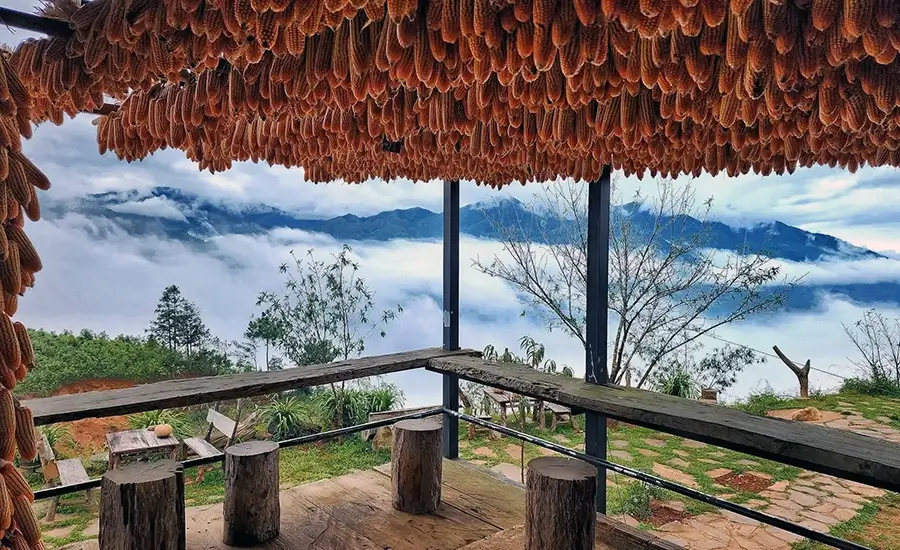
Yen Bai area has many accommodation options such as 2-3 star hotels and some homestays such as Hong Nhung – Yen Bai, Phuong Thuy, Nhu Nguyet, Thien Huong or more affordable motels. Room rates range from about 200,000 VND to 800,000 VND.
In addition to the above areas, Lao Cai also has outstanding accommodation locations in some wards with tourist attractions such as: Thac Ba Paradise Islands, Thac Ba Green Island Tourist Area (Thac Ba Lake), Vu Linh homestay Thac Ba, Om Tara Retreat, Nghia Lo area, Tram Tau… with room rates from 800,000 VND to 3 million VND per night.
Tourist attractions in Lao Cai
Famous towns and villages
Lao Cai
 The finial stop on Hanoi-Lao Cai railway is located on the Sino-Vietnamese border. The Chiese are of Coc Lieu is accessible from lao Cai by a steel bridge that also serves as a border gate.
The finial stop on Hanoi-Lao Cai railway is located on the Sino-Vietnamese border. The Chiese are of Coc Lieu is accessible from lao Cai by a steel bridge that also serves as a border gate.
Though small Lao Cai is considered by many as an exotic township. If you are in Lao Cai on time for the market, you can enjoy the happy, smilling faces of young girls of the ethnic minorites in their traditional colourful costumes. Going to the market is not exclusively for shopping, but it is also an opportunity for the girls to show their happiness and beauty to others, especially to young men.
Lao Cai is known for many historical and cultural relics and spiritual tourism attractions such as the Thuong temple complex, Cam temple, Quan temple, Doi Co temple, Cam Lo pagoda.
Sapa
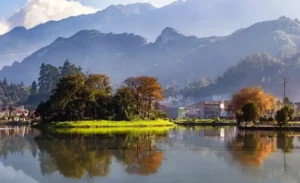 Sapa is a beautiful and remantic resort town, 39km from Lao Cai town. At the height of 1600 above sea leval, the average temperature of the area is 15-18C. It is cool in summer and cold in winter. Visitor to Sapa in summer can feel the climate of four seasons in one day. In the morning and afternoon, it is cool like the weather of spring and autumn. At noon, it is as sunny and cloudless as the weather of summer. And it is cold in the evening. From May to August, it rains a lot.
Sapa is a beautiful and remantic resort town, 39km from Lao Cai town. At the height of 1600 above sea leval, the average temperature of the area is 15-18C. It is cool in summer and cold in winter. Visitor to Sapa in summer can feel the climate of four seasons in one day. In the morning and afternoon, it is cool like the weather of spring and autumn. At noon, it is as sunny and cloudless as the weather of summer. And it is cold in the evening. From May to August, it rains a lot.
 In the town center, old and new villas with red roofs now appear and now disappear in the green rows of pomu trees, bringing the town the beauty of European towns. To the west of Sapa is the Hoang Lien Son mountain range, Fan Si Pan covered with cloud all year around. Conquering this mount is the passion of many dosmestic and foreign tourists.
In the town center, old and new villas with red roofs now appear and now disappear in the green rows of pomu trees, bringing the town the beauty of European towns. To the west of Sapa is the Hoang Lien Son mountain range, Fan Si Pan covered with cloud all year around. Conquering this mount is the passion of many dosmestic and foreign tourists.
Fresh and cool air in Sapa is an idea climate condition for growing temperate vegetables such as cabbage, chayote, precious medical herbs, and fruit trees such as plum, pear. Visitors to Sapa will have opportunities to discover the unique customs of the local residents. Particularly, the love market on every Saturday night is very attractive to tourists.
Mu Cang Chai
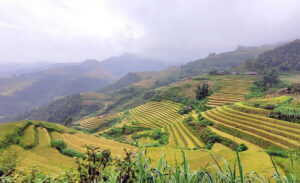 Mu Cang Chai is beautiful all year round. With terraced fields, the best season is the watering season from April to May. At that time, the fields look like giant mirrors. Then farmers will plant rice seedlings alternately, creating cool green and white patches. From September to October, Mu Cang Chai is golden yellow. This is also the most beautiful time, attracting the most photographers and tourists.
Mu Cang Chai is beautiful all year round. With terraced fields, the best season is the watering season from April to May. At that time, the fields look like giant mirrors. Then farmers will plant rice seedlings alternately, creating cool green and white patches. From September to October, Mu Cang Chai is golden yellow. This is also the most beautiful time, attracting the most photographers and tourists.
In other seasons such as winter or spring, Mu Cang Chai is bright pink with the thick flowers. The most prominent destinations in Mu Cang Chai: Thai Village, La Pan Tan terraced fields, Che Cu Nha, De Xu Phinh.
Tu Le
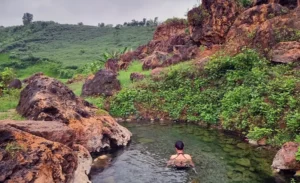 Tu Le Valley is located next to Mu Cang Chai, separated by Khau Pha Pass, and is a familiar destination for many backpackers on the way to explore Yen Bai. Tourists often combine visiting both Tu Le and Mu Cang Chai. This place is known for its charming Northwest landscape, fragrant sticky rice specialties, natural hot mineral springs and sacred customs of the Thai ethnic group.
Tu Le Valley is located next to Mu Cang Chai, separated by Khau Pha Pass, and is a familiar destination for many backpackers on the way to explore Yen Bai. Tourists often combine visiting both Tu Le and Mu Cang Chai. This place is known for its charming Northwest landscape, fragrant sticky rice specialties, natural hot mineral springs and sacred customs of the Thai ethnic group.
Unlike other places, Tu Le fields evoke a feeling of peace and closeness because they are not located precariously on hills or deep in ravines.
Nghia Lo
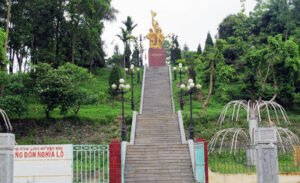 Nghia Lo is a place that tourists who want to visit famous tourist destinations in Lao Cai often have to stop by. The entire second largest field in the Northwest mountains is Muong Lo located in Nghia Lo town. Muong Lo is also famous for its hot springs, attracting tourists and locals. Muong Lo also has Shan Tuyet tea.
Nghia Lo is a place that tourists who want to visit famous tourist destinations in Lao Cai often have to stop by. The entire second largest field in the Northwest mountains is Muong Lo located in Nghia Lo town. Muong Lo is also famous for its hot springs, attracting tourists and locals. Muong Lo also has Shan Tuyet tea.
Nghia Lo also has the Nghia Lo Camp and Fort relic, recognized as a National Historical Site in 1996, preserving documents about the French colonialists detaining prisoners of war. To the north of Muong Lo basin is Thia stream (locally called “tears”), the stream bed is up to hundreds of meters wide during high water season.
Bac Ha
 Bac Ha ward is located in the northeast of Lao Cai province, at an altitude of about 1,000 to 1,500 m above sea level, with a temperate climate. Bac Ha has many historical and cultural relics and tourist attractions, including the San San (going down to the fields) festival of the H’mong and Tay people, Hoang A Tuong palace, Bac Ha temple, Trung Do ancient citadel site, brocade craft villages, and specialty corn wine brewing of the Mong people. Ethnic markets such as Lung Phin buffalo market, Bac Ha market, Coc Ly market, and Ban Lien market are also famous destinations.
Bac Ha ward is located in the northeast of Lao Cai province, at an altitude of about 1,000 to 1,500 m above sea level, with a temperate climate. Bac Ha has many historical and cultural relics and tourist attractions, including the San San (going down to the fields) festival of the H’mong and Tay people, Hoang A Tuong palace, Bac Ha temple, Trung Do ancient citadel site, brocade craft villages, and specialty corn wine brewing of the Mong people. Ethnic markets such as Lung Phin buffalo market, Bac Ha market, Coc Ly market, and Ban Lien market are also famous destinations.
 In particular, Bac Ha market is famous for its pristine beauty and the strong characteristics of the ethnic groups in the highlands of Vietnam. The market meets once a week on Sundays, and is a place for exchange, exchange of goods, and meeting with local ethnic groups. When going down the mountain, people often wear new colorful dresses to go to the market, considering it a festival. Bac Ha market is divided into small areas with specific exchange characteristics such as: brocade, cuisine, horse, poultry, food area. Each part is rich in diversity and imbued with local ethnic identity.
In particular, Bac Ha market is famous for its pristine beauty and the strong characteristics of the ethnic groups in the highlands of Vietnam. The market meets once a week on Sundays, and is a place for exchange, exchange of goods, and meeting with local ethnic groups. When going down the mountain, people often wear new colorful dresses to go to the market, considering it a festival. Bac Ha market is divided into small areas with specific exchange characteristics such as: brocade, cuisine, horse, poultry, food area. Each part is rich in diversity and imbued with local ethnic identity.
Not only is it a place for trading, the market also has a strong cultural identity, an ideal destination for tourists to experience the authentic and colorful highland life.
Lien village
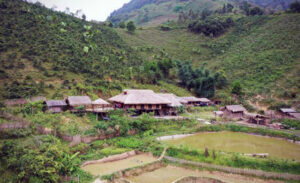 Lien village is a highland area located in Ban Lien commune, famous for its pristine beauty, cool climate all year round and unique cultural identity of the Tay people. About 30 km from the center of Bac Ha, this place attracts tourists with its winding terraced fields, ancient Shan Tuyet tea forests, moss-covered stilt houses and peaceful space imbued with the Northwest mountains and forests.
Lien village is a highland area located in Ban Lien commune, famous for its pristine beauty, cool climate all year round and unique cultural identity of the Tay people. About 30 km from the center of Bac Ha, this place attracts tourists with its winding terraced fields, ancient Shan Tuyet tea forests, moss-covered stilt houses and peaceful space imbued with the Northwest mountains and forests.
Traveling to Lien village, you can experience activities such as picking tea, catching stream fish, participating in the Long Tong festival or enjoying Shan Tuyet tea specialties.
Cat Cat Village
 Cat Cat Village is located 2 km from the center of Sa Pa, so you can choose to trek or ride a motorbike. This is a peaceful Mong village, still preserving many customs and traditional crafts such as weaving, silver carving, jewelry making…The road to the village is quite beautiful, you will pass through winding hairpin bends, on both sides are terraced fields with ethnic roofs peeking out.
Cat Cat Village is located 2 km from the center of Sa Pa, so you can choose to trek or ride a motorbike. This is a peaceful Mong village, still preserving many customs and traditional crafts such as weaving, silver carving, jewelry making…The road to the village is quite beautiful, you will pass through winding hairpin bends, on both sides are terraced fields with ethnic roofs peeking out.
Crossing Si Bridge is the center of Cat Cat Village, where three streams converge: Tien Sa Stream, Vang Stream and Bac Stream. Visiting the village, in addition to learning about the Mong people’s life, you also have the opportunity to buy handmade products as gifts and enjoy local products
Lao Chai – Ta Van
Ta Van Village is located about 10 km from Sapa town, a peaceful destination in the middle of Muong Hoa Valley with green terraced fields and the majestic Hoang Lien Son range. The road to Lao Chai – Ta Van is narrow, covered on both sides with a cool 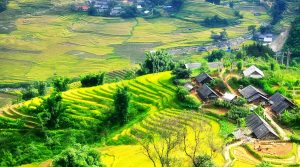 green color of terraced rice and corn fields. Although no longer wild and remote, Lao Chai – Ta Van is still a peaceful village with many ethnic groups living there such as Mong, Dao, Giay…
green color of terraced rice and corn fields. Although no longer wild and remote, Lao Chai – Ta Van is still a peaceful village with many ethnic groups living there such as Mong, Dao, Giay…
The most impressive thing here, besides the local ethnic life, is the terraced fields spread across the hillsides. Traditional stilt houses, small roads winding around rice fields, and rattan bridges over streams create a rustic, poetic space.
Late summer is the time when ripe rice turns the whole mountainous area golden. So if you have a lot of time, spend a day here to experience the indigenous lifestyle. Entrance fee to the village is 70,000 VND per person.
Mountain peaks and passes
Ham Rong Mountain
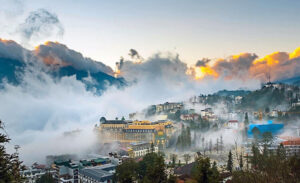 With its magical and mysterious scenery, Ham Rong Mountain is crowded with tourists. The lowest point of the mountain is 1,450m, and the highest peak is over 1,800m. From the top of the mountain, you can see most of the famous tourist attractions of Sapa town such as Muong Hoa valley, Ta Van village, Cat Cat village…
With its magical and mysterious scenery, Ham Rong Mountain is crowded with tourists. The lowest point of the mountain is 1,450m, and the highest peak is over 1,800m. From the top of the mountain, you can see most of the famous tourist attractions of Sapa town such as Muong Hoa valley, Ta Van village, Cat Cat village…
Ham Rong Mountain is suitable for organizing a picnic, combining eating and shopping, sightseeing because on the way up the mountain there are countless shops and beautiful flower gardens. The entrance fee to Ham Rong Mountain tourist area is 70,000 VND for adults and 30,000 VND for children.
Fansipan Peak
To reach Fansipan Peak without spending too much energy, take the cable car and the mountain train. In the morning, you line up to buy tickets at the mountain train station opposite Sapa town square. Cable car ticket price is 715,000 VND per adult, 525,000 VND 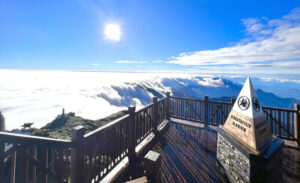 per child, mountain train ticket is 99,000 VND per person.
per child, mountain train ticket is 99,000 VND per person.
To reach the top of Fansipan, you take the mountain train route, then the cable car, then another train ride or walk up 600 steps. Each train ride lasts about 6-7 minutes, each cable car ride is about 30 minutes. Those who like to walk can leisurely climb the stairs, visit the spiritual complex on Fansipan with Kim Son Bao Thang Pagoda, the largest bronze statue of Amitabha Buddha in Vietnam…
In addition, at the cable car and mountain train stops, there are souvenir shops, restaurants… to serve the shopping and dining needs of tourists. Note: you should wear low-heeled shoes, bring a jacket, raincoat, or umbrella in case the weather on the mountain top suddenly turns cold and is foggy.
Nhiu Co San
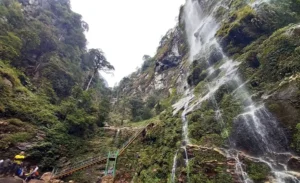 Nhiu Co San is a mountain peak nearly 2,965 meters high in Den Sang commune, Lao Cai province, known as “Buffalo Horn” thanks to its unique curved peak shape. This is an attractive trekking spot with diverse landscapes, from cardamom forests, grassy hills to the majestic Ong Chua waterfall.
Nhiu Co San is a mountain peak nearly 2,965 meters high in Den Sang commune, Lao Cai province, known as “Buffalo Horn” thanks to its unique curved peak shape. This is an attractive trekking spot with diverse landscapes, from cardamom forests, grassy hills to the majestic Ong Chua waterfall.
In winter, the mountain peak can be covered with ice and snow, in spring the rhododendron flowers are brilliant, creating a challenging yet poetic journey to conquer in the Northwest.
O Quy Ho Pass and Heaven’s gate
 O Quy Ho is known as the “King of the passes” with a deep valley on one side and a steep cliff on the other. O Quy Ho is about 50 km long, connecting the two provinces of Lao Cai – Lai Chau. A suggestion for those who want to take beautiful photos on this pass is to come at sunset, around 17 – 17:30 pm. When the sun gradually hides behind the mountains, the entire pass is covered in a beautiful, dreamy yellow color. However, the weather in Sapa changes very quickly, maybe only 10 minutes after the sun and sunset, the clouds have covered the area.
O Quy Ho is known as the “King of the passes” with a deep valley on one side and a steep cliff on the other. O Quy Ho is about 50 km long, connecting the two provinces of Lao Cai – Lai Chau. A suggestion for those who want to take beautiful photos on this pass is to come at sunset, around 17 – 17:30 pm. When the sun gradually hides behind the mountains, the entire pass is covered in a beautiful, dreamy yellow color. However, the weather in Sapa changes very quickly, maybe only 10 minutes after the sun and sunset, the clouds have covered the area.
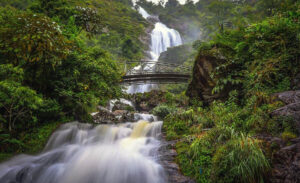 Along the pass to the Silver Waterfalls and Love Waterfalls, there are many stalls selling local specialties, food, drinks, and providing places for visitors to rest. When going to O Quy Ho Pass, you should bring a raincoat and a thick jacket, ride a motorbike, remember to wear a helmet and pay attention to each curve.
Along the pass to the Silver Waterfalls and Love Waterfalls, there are many stalls selling local specialties, food, drinks, and providing places for visitors to rest. When going to O Quy Ho Pass, you should bring a raincoat and a thick jacket, ride a motorbike, remember to wear a helmet and pay attention to each curve.
At the highest point of O Quy Ho Pass, you will reach Heaven’s Gate. Standing here, you can see the panoramic view of the vast valley below, the terraced fields interspersed with winding roads. Currently, there are many new constructions such as restaurants, cafes, hotels… Heaven’s Gate charges 80,000 VND per person, including a drink.
Beautiful lakes
Thac Ba Lake
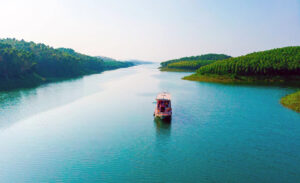 Thac Ba is an artificial lake with the area of 23,400 ha, the lake includes 1,331 hill islands a varied vegetation cover and diverse ecological setting. The water is blue and pure, reflecting the shade of the old woods surrounding the lake. The caves and grottos in hill-islands on the lake such as Hum (Tiger) Cave, Cau Cuoi Cave, Bach Xa (white Snake) Grotto, and Thac Ba Temple are attractive to tourists.
Thac Ba is an artificial lake with the area of 23,400 ha, the lake includes 1,331 hill islands a varied vegetation cover and diverse ecological setting. The water is blue and pure, reflecting the shade of the old woods surrounding the lake. The caves and grottos in hill-islands on the lake such as Hum (Tiger) Cave, Cau Cuoi Cave, Bach Xa (white Snake) Grotto, and Thac Ba Temple are attractive to tourists.
Thac Ba Lake is not only a scenic spot but also a historical place. In 1285, this area withnessed a battle in which General Tran Nhat Duat defeated Yuan-Mongolian troops. In the Upper Lake, there remian several vestiges of the offices of Central agencies in the anti French resistance. In the middle of the lake stands the Mong Son Grotto, which housed the Yen Bai Party Committee during the anti-American resistance.
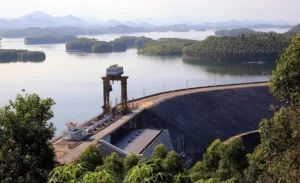 The Thac Ba hydroelectric Station is the first of its kind built in Vietnam.
The Thac Ba hydroelectric Station is the first of its kind built in Vietnam.
A master plan is being drafted to develop Thac Ba lake into an eco-tourist centre where tourists can relax by the lake or climb the mountain and explore the forests.
The reach Thac Ba lake from Yen Bai, travel along Hao Gia Road about 5km, then Go Mo Hill (10km) to Lang Dat (the way leading to Rang St. 19km) to the Vu Khe Road junction. Then turn left and continue for about 4km to Yen Binh District.
Seo My Ty Lake
To get to Seo My Ty Lake, in Ta Van commune, you have to cross a 20 km long road with many large and small rocks, so it is quite challenging for weak drivers. The lake was created by the dam to build the Seo My Ty hydroelectric plant and is also the highest 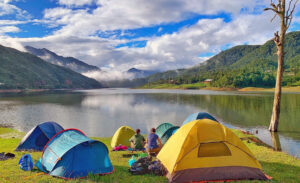 artificial lake in Vietnam. Seen from above, the lake looks like a silk strip on the Hoang Lien Son mountain range.
artificial lake in Vietnam. Seen from above, the lake looks like a silk strip on the Hoang Lien Son mountain range.
Visitors can trek to explore Hoang Lien mountains and forests, or camp and row boats by the lake, which are indispensable experiences when coming to Seo My Ty. There is also a famous check-in point, the 16 km long Seo Trung Ho Stream, with activities such as crossing streams, conquering 3-tier waterfalls and immersing in the emerald green water of Dragon Waterfall. Furthermore, you can ask permission from fishermen to sit on the boat or raft to admire the lake and learn about the salmon farming of the local people.
Historical and cultural relics
Hoang Yen Tchao Castle
 Hoang Yen Tchao Castle also know as Hoang A Tuong Palace is an ancient architectural work located in the center of Bac Ha Town, Lao Cai Province, associated with the history of the white plateau. Built in 1914 and completed in 1921, the mansion was once the residence and workplace of the father and son of the local governor Hoang Yen Tchao and Hoang A Tuong, who held great power during the French colonial period.
Hoang Yen Tchao Castle also know as Hoang A Tuong Palace is an ancient architectural work located in the center of Bac Ha Town, Lao Cai Province, associated with the history of the white plateau. Built in 1914 and completed in 1921, the mansion was once the residence and workplace of the father and son of the local governor Hoang Yen Tchao and Hoang A Tuong, who held great power during the French colonial period.
With an area of over 4,000 square meters, the work includes 36 rooms, a large tiled yard and a closed corridor system, with an architectural style combining Asia and Europe.
Ancient rock field
The ancient rock field of Sapa stretches across the Muong Hoa valley in the communes of Hau Thao, Su Pan and Ta Van, around Muong Hoa stream (Hoa stream) in the Muong Hoa valley, about 7 km southeast of Sapa town.
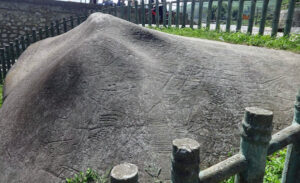 The ancient stone field has existed in the lives of Lao Cai people for many generations. However, people only recognized this relic from a scientific perspective when V. Goloubew, a French archaeologist, discovered ancient characters in 1925.
The ancient stone field has existed in the lives of Lao Cai people for many generations. However, people only recognized this relic from a scientific perspective when V. Goloubew, a French archaeologist, discovered ancient characters in 1925.
This 8km² area of the remains consists of large multi-grade rocks engraved with ancient images, it’s located in the Muong Hoa valley, between the terraced rice paddies of ethnic minority groups. The first exploration research, in 1925, recorded that were 200 stones of various dimensions concentrated in the area. Remarkably, among the engravings are drawings of humans, stilt-house of the ethnic minorities and symbols believed to be a primitive form of writing. But their meaning has not yet been deciphered.
Sapa Stone Church
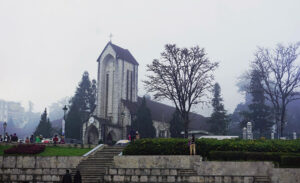 Located right behind the majestic Ham Rong range, Sapa Stone Church is a tourist attraction and religious tourist attraction that attracts many people. This is a symbolic work of the mountain town, started in 1895.
Located right behind the majestic Ham Rong range, Sapa Stone Church is a tourist attraction and religious tourist attraction that attracts many people. This is a symbolic work of the mountain town, started in 1895.
The church was built in the shape of a cross in the Gothic style, expressed in the roof, spacious land with 7 rooms, a 20-meter-high bell tower, and a half-ton bell… all of which are pyramidal, creating a graceful and airy look for the work. Coming here, you can visit, attend Mass or listen to the H’Mong children sing hymns very well.
Dai Cai temple
Hac Y Hill about 80km from Yen Bai ward. This complex includes the Black-Cloth King Mountain and Dai Cai Temple. The Black-Cloth King Mountain is natural masterpiece.  Legend is that this was place where Black Cloth King (under Tran Dynasty) flew into the sky. On the top, there is a garden, a fish raising pond and remains of religious monuments from the Ly and Tran periods. Nowadays, staying on Dai Cai Temple, tourists will see the statue of the Black-Cloth King and his horse on the top of the mountain.
Legend is that this was place where Black Cloth King (under Tran Dynasty) flew into the sky. On the top, there is a garden, a fish raising pond and remains of religious monuments from the Ly and Tran periods. Nowadays, staying on Dai Cai Temple, tourists will see the statue of the Black-Cloth King and his horse on the top of the mountain.
The Dai Cai temple which was built by the bank of the Chay River, faces the river and the gates of Hac Y hill. Dai Cai temple was built on a large area covered with many green trees and attractive riverside roads. In the Cai Dai temple area, many stone tools have been found which specific characteristics of the Son Vi culture. The Dai Cai temple festival annually takes place on the 16th day of the 1st lunar month.
Dong Cuong Temple
Dong Cuong Temple also called Mau Thuong Ngan, is about 50km from the city of Yen bai, on the right bank of Red Rier, set amidst picturesque scenery where the mountains and rives harmoniously meet. The architecture of Dong Cuong Temple has a 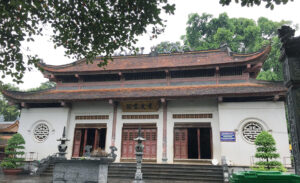 strong ancient character, including a main worship hall and a forbidden palace associated with the space for practicing the Mother Goddess worship of the Vietnamese people. Archaeologists have found many remains of the Son Vi culture (post-stone age period) in the Dong Cuong temple area.
strong ancient character, including a main worship hall and a forbidden palace associated with the space for practicing the Mother Goddess worship of the Vietnamese people. Archaeologists have found many remains of the Son Vi culture (post-stone age period) in the Dong Cuong temple area.
In addition to worshiping the Thuong Ngan Mother Goddess, Dong Cuong Temple also worships the Ve Quoc (National Defense) – the local gods who contributed to the resistance war against the Mongolian aggressors, and died in battle in 13rd century.
Dong Cuong Temple Festival is held in January every year with many traditional rituals. The festival part of the ceremony is organized with many cultural activities and folk games of the ethnic groups in Van Yen area.
Lao Cai specialties
Sapa in particular and the Northwestern mountainous provinces in general possess extremely unique specialties. Let’s take a look at the list of dishes you cannot miss when coming to explore Sapa.
Thang Co
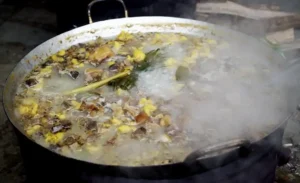 Thang Co is a soup made from beef, buffalo meat, horse organs, stewed bones, raw vegetables and many special spices – similar to beef and pork hotpots in Southern Vietnam. This is actually a traditional delicacy of the H’Mong people, which has been exiting for nearly 200 years.
Thang Co is a soup made from beef, buffalo meat, horse organs, stewed bones, raw vegetables and many special spices – similar to beef and pork hotpots in Southern Vietnam. This is actually a traditional delicacy of the H’Mong people, which has been exiting for nearly 200 years.
Thang Co is usually cooked in a large, dark, fatty pan. It has a bitter taste of horse intestines. Nowadays, thang co has been varied with a variety of ingredients to suit everyone’s taste. Steaming pans of thang co in a corner of Bac Ha market are a feature that attracts tourists to this highland market, especially in winter. A bowl of thang co costs about 30,000 VND.
Smoked buffalo meat
 The smoked buffalo meat is one of the famous specialties of Sapa. This is always considered a gift for relatives and friends after each trip to Sapa. Fresh buffalo meat, after being marinated with spices, will be smoked with wood smoke until the outer layer of meat is completely dry and turns dark reddish brown.
The smoked buffalo meat is one of the famous specialties of Sapa. This is always considered a gift for relatives and friends after each trip to Sapa. Fresh buffalo meat, after being marinated with spices, will be smoked with wood smoke until the outer layer of meat is completely dry and turns dark reddish brown.
This is a specialty of the Black Thai ethnic group. It has a salty taste and a characteristic pungent aroma from many spices, which creates very popular with culinary enthusiasts.
Carried-under-arm pig
 The dish is made from free-range pigs raised by the Mong ethnic group. It is modest in size, only about 5kg to 6kg each. When going to the market, people often “carry” pigs under their arms to sell, so they are always known by this impressive name – Carried-under-arm pig.
The dish is made from free-range pigs raised by the Mong ethnic group. It is modest in size, only about 5kg to 6kg each. When going to the market, people often “carry” pigs under their arms to sell, so they are always known by this impressive name – Carried-under-arm pig.
Because they are often run and exercise, the pork is chewy, soft, and firm with alternating meat and fat. It is most delicious when grilled over hot coals until the skin is golden brown and crispy. Gathering around the fire, enjoying grilled pork and drinking apple wine is a refreshing pleasure for the locals.
Rainbow trout
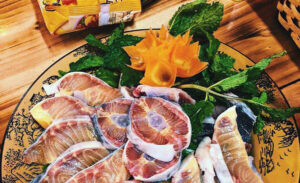 Sapa rainbow trout often living in stagnant water with low temperatures. The eye-catching orange-red meat of rainbow trout has firm, evenly arranged fibers, soft and fatty but not greasy. You can eat rainbow trout as sashimi (raw fish with wasabi), mixed in salad, cooked with pepper, grilled… all delicious.
Sapa rainbow trout often living in stagnant water with low temperatures. The eye-catching orange-red meat of rainbow trout has firm, evenly arranged fibers, soft and fatty but not greasy. You can eat rainbow trout as sashimi (raw fish with wasabi), mixed in salad, cooked with pepper, grilled… all delicious.
One of the most popular Sapa delicacies with tourists is rainbow trout hotpot. Fresh rainbow trout meat mixed with sweet and sour broth, dipped in hotpot with all kinds of fresh Northwest vegetables.
Seven- color sticky rice (Nung Din sticky rice)
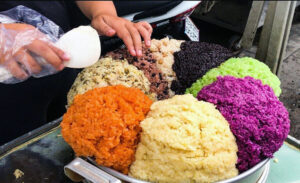 When mentioning delicious Sapa dishes, we must immediately mention seven-color sticky rice. This is a traditional Sapa delicacy that often appears during Tet holidays or the first day of the seventh lunar month every year. Seven colors of sticky rice: bright red, dark red, brown, purple, yellow, blue and green represent the seven months of the Nung Din ethnic group’s long-term resistance war. To honor the glorious achievements and show gratitude to the heroes who fell in the war against the invaders.
When mentioning delicious Sapa dishes, we must immediately mention seven-color sticky rice. This is a traditional Sapa delicacy that often appears during Tet holidays or the first day of the seventh lunar month every year. Seven colors of sticky rice: bright red, dark red, brown, purple, yellow, blue and green represent the seven months of the Nung Din ethnic group’s long-term resistance war. To honor the glorious achievements and show gratitude to the heroes who fell in the war against the invaders.
The rice used to make seven-color sticky rice must be delicious sticky rice with round, long and plump grains. Although it looks colorful, the color of the sticky rice is completely taken from natural ingredients. Thanks to that, each color of sticky rice will have a very unique aroma and natural sweetness, although simple but not overshadowed in the colorful Sapa cuisine.
Grilled stream fish
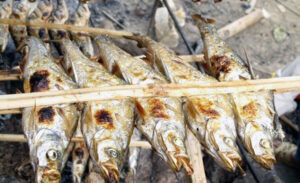 It would be a pity to come to Lao Cai without having enjoyed grilled stream fish. Sapa stream fish usually small in size, only the size of a hand or a knife handle. In return, the fish meat is naturally delicious, firm and not fishy. Breathe in the cool, fresh air, listen to the sound of flowing water, eat a piece of grilled fish and warm up with some San Lung Tay Bac wine.
It would be a pity to come to Lao Cai without having enjoyed grilled stream fish. Sapa stream fish usually small in size, only the size of a hand or a knife handle. In return, the fish meat is naturally delicious, firm and not fishy. Breathe in the cool, fresh air, listen to the sound of flowing water, eat a piece of grilled fish and warm up with some San Lung Tay Bac wine.
It is truly a rare experience of freedom in the world. Besides grilled stream fish, crispy fried stream fish is also very popular with foodies.
What’s the buy as gifts?
Tao Meo wine
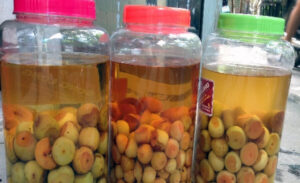 The main ingredient to make this local wine is eponymous wild apples (Docynia indica) growing in the northern mountains. Embracing the spirit of the mountains and forests, eponymous wild apples have a unique bitter and sweet and sour taste. When soaked in wine, it will create a very characteristic aroma and yellow color.
The main ingredient to make this local wine is eponymous wild apples (Docynia indica) growing in the northern mountains. Embracing the spirit of the mountains and forests, eponymous wild apples have a unique bitter and sweet and sour taste. When soaked in wine, it will create a very characteristic aroma and yellow color.
The wine has a spicy and pungent aroma, followed by a lingering sweetness on the tip of the tongue. The wine also has the effect of treating headaches, dizziness, helping to calm the mind, and helping to sleep, so tourists often buy it to give to relatives and friends.
Mu Cang Chai Forest Honey
Wild honey is a specialty that many tourists choose to bring back as gifts. Thanks to the abundance of hundreds of wild flowers, the bee colonies in Mu Cang Chai have created a thick, golden honey, combining the aroma and sweetness of the mountains and forests. This is the type of honey that bees make nests in caves and tree holes, has a pure sweetness, does not crystallize, and has a health-enhancing effect.
Fruits
Lao Cai has three types of fruit that are well known to many people: Vinh Lac persimmons, Tan Linh oranges, and Minh Xuan tangerines with crispy skin. Vinh Lac persimmons bloom during the Mid-Autumn Festival. The fruit is soaked in clean water for about 36 hours, then taken out to drain, peeled off the outer skin, and cut into pieces. Persimmons are bright yellow, sweet, cool, seedless, and crispy. Tan Linh oranges have a yellow-brown color, rough and thick skin. The orange segments are peeled, not sticky, and juicy, with a rich sweetness. Luc Yen crispy tangerines have a bright pink color with green spots, are crispy and easy to peel. The tangerines are fragrant and juicy.
Shan Tuyet Tea
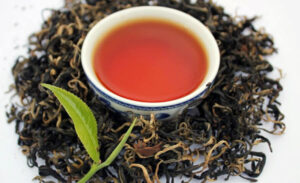 Shan Tuyet tea is made from ancient tea trees hundreds of years old grown on the top of Suoi Giang (Van Chan ward) at an altitude of nearly 1,400 m above sea level. Shan Tuyet tea trees have moldy white trunks, many branches and are tall, forcing harvesters to climb up to pick. Thanks to the cool, cloudy climate all year round, the tea buds and leaves here are large, covered with a layer of fine, white fluff.
Shan Tuyet tea is made from ancient tea trees hundreds of years old grown on the top of Suoi Giang (Van Chan ward) at an altitude of nearly 1,400 m above sea level. Shan Tuyet tea trees have moldy white trunks, many branches and are tall, forcing harvesters to climb up to pick. Thanks to the cool, cloudy climate all year round, the tea buds and leaves here are large, covered with a layer of fine, white fluff.
Shan Tuyet tea is harvested three times a year, and is always ranked at the top of the list of teas thanks to the “five extremes”: “Extremely hard” when growing and harvesting, “extremely clean” due to climate conditions, environment and care, “extremely rare” because of low yield, “extremely delicious” thanks to its aroma, rich flavor, and green water.
Green sticky rice
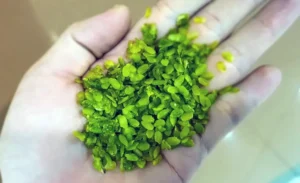 Tu Le commune is famous for its special sticky rice variety that produces batches of green rice, which are best eaten right after being made. The harvested rice must be processed on the same day. After removing the broken grains, the rice is roasted, then cooled and pounded in a stone mortar. All steps in making Tu Le green sticky rice are done by hand. It has soft, sticky, fragrant grains, with a slightly bitter aftertaste that then turns to a light and slightly sweet taste.
Tu Le commune is famous for its special sticky rice variety that produces batches of green rice, which are best eaten right after being made. The harvested rice must be processed on the same day. After removing the broken grains, the rice is roasted, then cooled and pounded in a stone mortar. All steps in making Tu Le green sticky rice are done by hand. It has soft, sticky, fragrant grains, with a slightly bitter aftertaste that then turns to a light and slightly sweet taste.
Green sticky rice is often eaten with red persimmons, bananas or cooked with duck porridge, sticky rice, sweet soup and made into savory dishes such as sausage, fried spring rolls.
Source: collected by An
Follow us for the best deal with Vietnam package tours and visa services!
